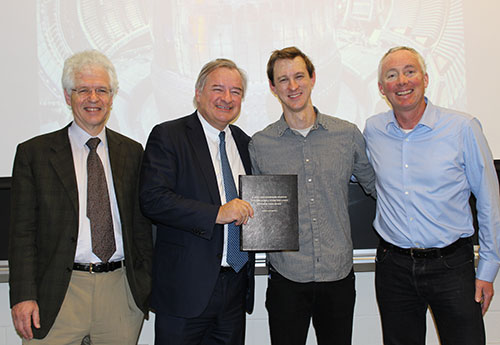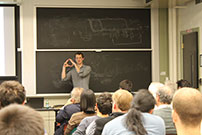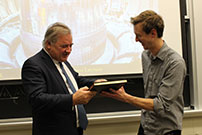Del Favero Lecture: The future of fusion power

The next two years in MIT’s Nuclear Science and Engineering Department may see fusion research embark on a landmark period of innovation. In his address to the NSE community in the inaugural Del Favero Doctoral Thesis Prize Lecture, Dr. Zach Hartwig not only described his group’s research achievements but also explained why, in his view, fusion research should now be at the top of the department’s agenda. Hartwig argued that U.S. fusion research, which has been focused on physics for the past two decades, now needs to incorporate more attention to engineering, utility integration, and economics as it transitions to building devices that will produce energy, and that this can be achieved by leveraging the tremendous engineering and systems expertise of NSE.
Much of Hartwig’s PhD research centered on developing a new and substantially improved method for studying materials in fusion environments. Thanks to the geometry and power density of tokamak reactors, the materials on their plasma-facing walls must withstand power fluxes higher than the space shuttle upon re-entry, as well as a host of complex physical and chemical interactions that completely remake the material surfaces. The diagnostic that Hartwig helped develop, Accelerator-Based In-Situ Materials Surveillance (AIMS), utilizes recent advances in detector technology to offer scientists a more comprehensive view, over large areas of the surface, of how the plasma affects these materials on a very granular timescale. Prior to AIMS, scientists were only able to analyze a small sample of the first-wall material every 6 months. AIMS will enable the research team at MIT’s Alcator C-mod reactor to study multiple important sections of the wall between every plasma shot, approximately one location every 30–60 seconds.
In a separate project focusing on the design of fusion devices to solve the plasma-surface problem, Hartwig and several other graduate students working with Professor Dennis Whyte identified the potential for a new class of compact tokamaks. Hartwig pointed out that new developments in high temperature superconductors could enable higher magnetic fields and consequently much smaller and lower-cost fusion experiments. Reducing the size of experiments could accelerate the pace of advance in fusion science affecting key problems such as divertor materials and tritium breeding. Hartwig and the rest of Whyte’s group also believe that experiments should be moving the field toward nuclear fusion’s ultimate purpose: putting power on the grid. In this regard, Hartwig described two new experiments, the Advanced Divertor Experiment (ADX) and the Affordable, Robust, Compact (ARC) reactor. The first studies materials and divertor problems in greater depth, while the second — a fusion reactor that is half the size of conventional designs — incorporates lessons from fission engineering to simplify the tritium breeding blanket and maintenance problems. Hartwig argued that MIT has a unique opportunity to direct the future of fusion energy research by building these two new experiments to address both the surfaces (ADX) and the scale (ARC) of an operating fusion power reactor.


Related
- Zach Hartwig applies physics, teamwork to create new tools for fusion energy science
- NSE’s Dennis Whyte named Director of the Plasma Science and Fusion Center
Written by Jacob Jurewicz
Photos by Aditi Verma
